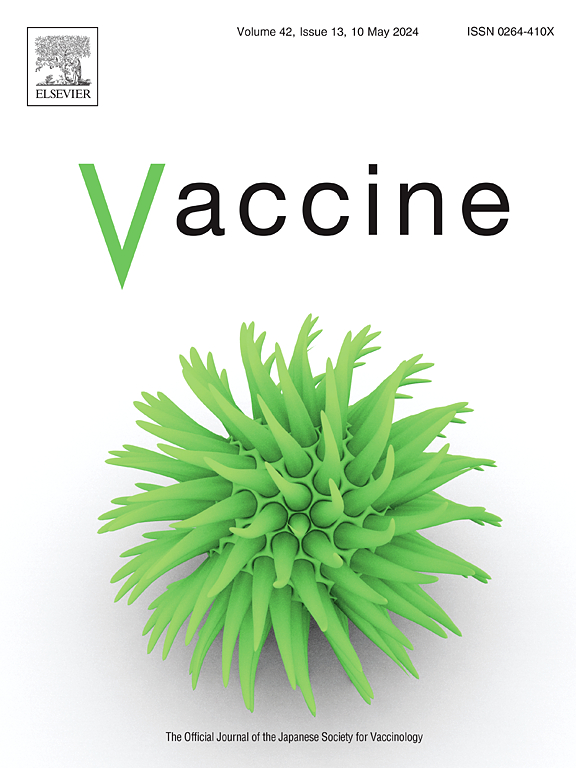Long-term antibody responses to the Ebola virus and the vaccine vector after rVSV-ZEBOV vaccination in DRC
IF 4.5
3区 医学
Q2 IMMUNOLOGY
引用次数: 0
Abstract
Zaïre ebolavirus (EBOV) remains a serious threat with a high case fatality rate in humans, particularly in the Democratic Republic of Congo (DRC). To cope with previous epidemics, the single-dose and prophylactic rVSV-ZEBOV vaccine was widely applied. However, evidence on the duration of protection and, consequently, the need or timing for booster doses is lacking. Therefore, we investigated in a cross-sectional study design the antibody persistence and neutralizing capacity against three strains of the Orthoebolavirus zaïrense species within healthcare workers (HCWs) who were previously vaccinated in different outbreaks across DRC. The presence of vector-directed immunity was studied via seropositivity to VSV proteins.
In total, 133 HCWs were recruited and grouped according to their time from initial vaccination (1−2, 2−3, >3 years), in addition to a control group of 20 unvaccinated HCWs. In 1–2 year vaccinated participants (n = 10), an overall high antibody response (100 % seropositivity) specific to the vaccine-targeted EBOV glycoprotein (GP) of the Kikwit strain was observed, in comparison to <50 % seropositivity to the Mayinga and Kissidougou GP EBOV variants. This antibody trend persisted up to 4 years after vaccination, but overall seropositivity rates decreased to 76.8 % (Kikwit), 38.3 % (Mayinga), and 44.6 % (Kissidougou) for participants vaccinated >3 years ago. Only a minority (n = 6) among all time groups of HCWs with high antibody titers still had demonstrable neutralizing capacity. No persistent VSV-specific antibody responses were observed at any time, suggesting no to low interference with booster doses.
Complementing prior findings, our results thus suggest a persistently detectable but strain-specific and slowly declining antibody response to EBOV up to 4 years after vaccination. Our data supports the administration of booster doses after 1–2 years for optimal protection, highlights potential strain-restrictive vaccine-induced immunity, and may inform on correlates of long-term protection.
刚果民主共和国接种rVSV-ZEBOV疫苗后对埃博拉病毒和疫苗载体的长期抗体反应
Zaïre埃博拉病毒(EBOV)仍然是一个严重威胁,人类病死率很高,特别是在刚果民主共和国(DRC)。为应对以往流行,广泛采用单剂量、预防性的rVSV-ZEBOV疫苗。然而,缺乏关于保护持续时间的证据,因此缺乏加强剂量的必要性或时间。因此,我们在一项横断面研究设计中调查了在刚果民主共和国不同疫情中接种过疫苗的卫生保健工作者(HCWs)体内针对三种正埃博拉病毒zaïrense菌株的抗体持久性和中和能力。通过对VSV蛋白的血清阳性研究了载体定向免疫的存在。总共招募了133名卫生保健员,并根据他们接种疫苗的时间(1 - 2年、2 - 3年和3年)进行分组,另外还有20名未接种疫苗的卫生保健员作为对照组。在接种疫苗1-2年的参与者(n = 10)中,观察到Kikwit菌株疫苗靶向EBOV糖蛋白(GP)的总体高抗体反应(100%血清阳性),而Mayinga和Kissidougou GP EBOV变体的血清阳性为50%。这种抗体趋势在接种疫苗后持续4年,但3年前接种疫苗的参与者的总体血清阳性率降至76.8%(基奎特)、38.3%(马延加)和44.6%(基西杜古)。在所有高抗体滴度的HCWs组中,只有少数(n = 6)仍然具有明显的中和能力。任何时候都没有观察到持续的vsv特异性抗体反应,这表明加强剂量没有或低干扰。因此,我们的研究结果补充了先前的研究结果,表明在接种疫苗后4年内,对EBOV的抗体反应持续可检测到,但具有菌株特异性,并且缓慢下降。我们的数据支持在1-2年后给予加强剂量以获得最佳保护,强调了潜在的菌株限制性疫苗诱导免疫,并可能告知长期保护的相关因素。
本文章由计算机程序翻译,如有差异,请以英文原文为准。
求助全文
约1分钟内获得全文
求助全文
来源期刊

Vaccine
医学-免疫学
CiteScore
8.70
自引率
5.50%
发文量
992
审稿时长
131 days
期刊介绍:
Vaccine is unique in publishing the highest quality science across all disciplines relevant to the field of vaccinology - all original article submissions across basic and clinical research, vaccine manufacturing, history, public policy, behavioral science and ethics, social sciences, safety, and many other related areas are welcomed. The submission categories as given in the Guide for Authors indicate where we receive the most papers. Papers outside these major areas are also welcome and authors are encouraged to contact us with specific questions.
 求助内容:
求助内容: 应助结果提醒方式:
应助结果提醒方式:


